Session 10: Contemporary American Literature - Recent Trends
1/22
There's no tags or description
Looks like no tags are added yet.
Name | Mastery | Learn | Test | Matching | Spaced |
|---|
No study sessions yet.
23 Terms
What comes after Postmodernism?
Modernism → Postmodernism → various approaches presented in literary scholarship:
continued postmodernism,post-postmodernism, metamodernism, …
(Slowly) Turning Away from the Postmodernist Paradigm
• as early as 1993, David Foster Wallace noted a shift away from the postmodern irony
toward a “literature of sincerity” (“E Unibus Pluram: Television and U.S. Fiction”)
• rise and return of certain genres: memoirs = best-sellers, ethnic Bildungsroman, social
realism
• postmodernism has increasingly disappeared from scholarship on recent literature and
from syllabi on “Contemporary American Literature”
→ turn from playfulness of postmodernism, turn to new realism
→ sense that postmodernism doesn’t capture the Zeitgeist anymore, e.g. lack of political
commitment that can generate ‘actual results’ [see how philosophy, politics, and the arts
come together?
post-postmodernism
for lack of a better term (2004)
metamodernism
• myriad crises of the past two decades ( climate change, financial meltdown, of democracy, global conflicts) → desire for change (again)
• resurgence of sincerity, hope, romanticism, the potential for ‘universal truths’ without giving up on postmodernist insights
• often texts (cultural products) move between sincerity and irony, deconstruction and construction, apathy and affect
9/11 and Post-Postmodernism
request/desire to move
• (away) from postmodernist playfulness and arbitrariness
• to serious topics and approaches, call to return to ‘reality’
• 9/11 shocked the nation (and the rest of the world), vulnerability, national trauma, 3000 deaths in the attacks, thousands more in the aftermath → feeling of loss and horror – how does one cope?
• Tod Gitlin’s hypothesis/claim: 9/11 as the death of postmodernism
Carl Stilwell, “On Crossing Brooklyn Ferry, September 11, 2001” First Part
references Walt Whitman’s “Crossing Brooklyn Ferry” (1856); Whitman as poet of American democracy and unity
➢ unity between speaker and New Yorkers – “I am with you”
• references to Ginsberg's poem “Howl” and Kerouac’s novel On the Road
➢ unity extended to include the rest of America – “and you…”
“WE the PEOPLE” – reference to the Declaration of Independence here points t
• Promise of being with victims, helpers, relatives
• Direct address by name → intimate relationshipo connection through the experience of 9/11
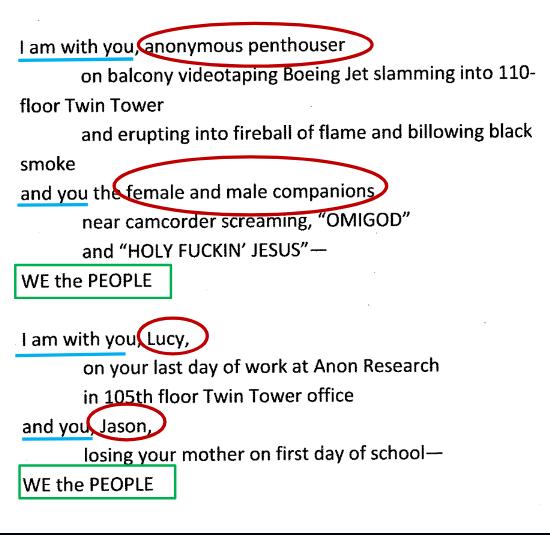
Carl Stilwell, “On Crossing Brooklyn Ferry, September 11, 2001” Second Part
there is still life among destruction, what the lyrical I sees → witness
Statue of Liberty: sign of hope, symbol of freedom
Emma Lazarus poem, “The New Colossus”: “Give me your tired, your poor, Your huddled masses yearning to breathe free”
collective, communal mourning: symbol of the flag across the nation and across religions (“churches, synagogues, Buddhist temples and Islamic centers”)
inclusive and diverse version of America
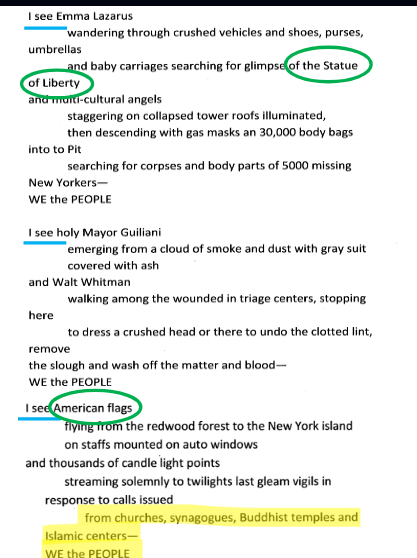
Carl Stilwell, “On Crossing Brooklyn Ferry, September 11, 2001” Third Part
what the lyrical I hears →ear witness, withdraws from scene(s)
• Palestinians rejoice and chant
• American calls for revenge – polarization, “them” vs. “us”
• the horror of revenge: hears shots, violence creates more violence – once again calls for unity instead of division;
→ fear, terror, and division must not win
Carl Stilwell, “On Crossing Brooklyn Ferry, September 11, 2001” Final Part
careful hope and anticipation of the best of the American tradition
• Coltrane’s Jazz as merger of terror and triumph; survival mode, beauty amidst the greatest tragedy
• may the good overcome evil; wish for an end of violence (Ginsberg evoking “Mohandas Ghandi”, “Martin Luther King”)
• no certainty, no reason to rejoice “somehow overcome” as “WE the PEOPLE”
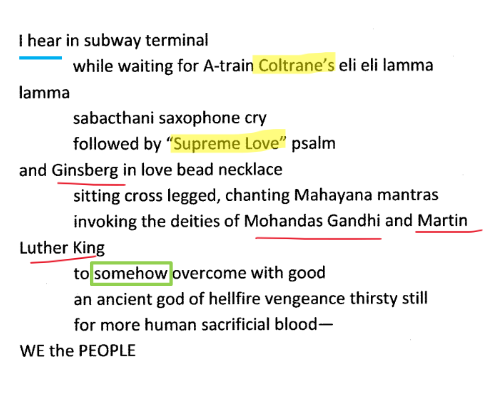
features of Post-Postmodernism in Carl Stilwell, “On Crossing Brooklyn Ferry, September 11, 2001” Final Part
desire for change
no playfulness
Layli Long Soldier
• * 1972 in the Southwest
• citizen of the Oglala Lakota Nation; lives in Santa Fe, New Mexico
• poetry collection Whereas (2017) won the National Books Critics Circle award, was a finalist
for the National Book Award
Obligations 2
• choices the reader must make → agency
• Agency = limited and conditional: beginning and end = only one option; “the grief” = unavoidable
• first and last line = communality “we” / “our”; speaker and others become one
• continuity and connectedness of past, present, future
• numerous possible paths through the poem
– but they all invariably lead to “the grief”
→ personal dimension
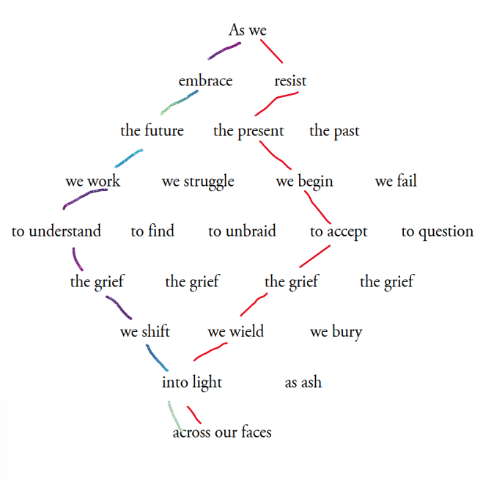
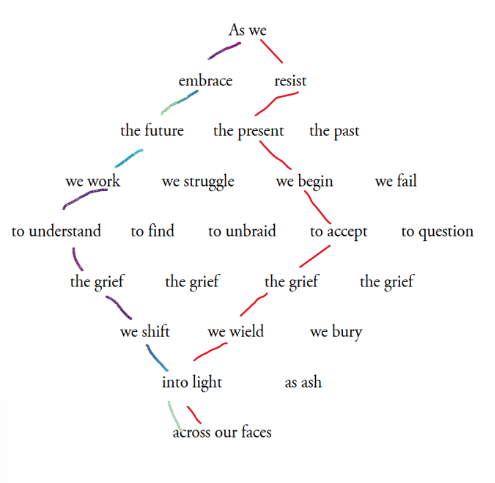
Obligations 2 in context of Native American History
• Native American history as a history of genocide and displacement that must be
faced and wrestled with for a future,justice;
• the US must but also can (“agency”) come to terms with settler colonialism, white supremacy, and their aftermath
→ political dimension, cultural memory, national myths: how to deal with historical
injustice?
Form/Shape in Obligations 2
form/shape: diamond
unity and separation; unity in/despite multiplicity of experiences?
pressure needed for it to emerge
Claudia Rankine
*1963
• professor of literature at Yale University
• author of five books, most recently Citizen: An American Lyric (2014); Just Us (2020), poet, essayist, playwright
• recipient of a 2015 Mc Arthur fellowship
The Cover of Citizen (2014) the hood
image from 1993
reference to Trayvon Martion’s death: emergence of BLM
a Black hood suspended in white space: recalls quote from Zora Neale Hurston that
keeps cropping up in Citizen: ‘I feel most colored when I am thrown against a sharp
white background’
becomes an executioners headdress too
Rodney King
• 1965-2012
• Rodney King was brutally beaten and assaulted by police after refusing to pull over for a traffic stop in LA 1991
• Beating was caught on camera; but none of the officers was found guilty of excessive use of violence at trial in 1992
• Soon after, riots broke out in LA (and elsewhere): 63 deaths, 2,383 injuries, more than 7,000 fires, damage to 3,100 businesses
• Received roughly $4 million in settlement; several rounds of therapy, even televised therapy
• Found dead in his pool in 2012 – “accidental drowning” under the influence
Genre/Style of Citizen
both poetic and political work, mediation of activist struggles and literary aesthetics
→ hybrid of various genres prose poetry, visuals, essays, collage-like
Microaggressions
Microaggressions are the everyday verbal, nonverbal, and environmental slights,
snubs, or insults, whether intentional or unintentional, which communicate hostile,
derogatory, or negative messages to target persons based solely upon their
marginalized group membership.
Everyday Microaggressions in Citizen
The girl at Catholic school who copies during tests and later says “you smell good and have
features more like a white person.” (5)
“You are in the dark, in the car, watching the black-tarred street being swallowed by speed;
he tells you his dean is making him hire a person of color when there are so many great
writers out there” (10)
“The new therapist specializes in trauma counseling. […] When the door finally opens, the
woman standing there yells, at the top of her lungs, Get away from my house! What are you
doing in my yard?” (18)
→ collected from personal experience, conversations with friends – aestheticized expression
of the experience of racism, trauma, alienation
You-Speaker in Citizen
the first person would have deactivated the scene… The second-person you, however, makes it difficult for readers to withdraw from the scenes because it implies all readers.”
reader feels constantly called upon
Trayvon Martin
• in 2012, 17-year-old African American youth, was fatally shot in Sanford, Florida by George Zimmerman, a neighborhood watchman
• claiming self-defense, Zimmerman was found not guilty of murdering Trayvon Martin
• sparked the emergence of #blacklivesmatter
The force of racism in Ciitizen
• the past – steeped in a history of white supremacy – undergirds every moment both public and private
• continuity of experience and interruption/disruption of the experience of the self
• everydayness of racism
• whiteness is embodied – often operates unconsciously/pre-reflectively in bodily habits, movements, and perceptions
→expressed lyrically and intimately in Citizen
→ affective approach, reader can feel ‘caught’
→a long shot from postmodernism’s heyday – new sincerity, (re)turn to ethical
topics, text positions itself in debates